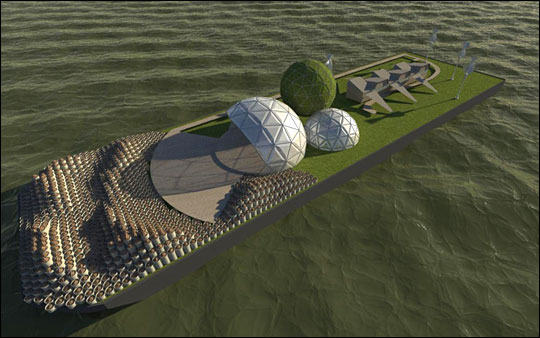Take a good look at your plot of dry land now, folks, because according to the latest projection, the oceans could rise up to 21 feet in some places. Already, island nations being sipped up by the sea are investing in water-hugging houses (or land suitable for relocation), and flood-prone places like the Netherlands have been working on their aqua-adjusting floating homes for years. Now a group of New Yorkers is at work on another water-top habitat that will embrace the rising waters.
<p>Enter the <a href="http://thewaterpod.org/">Waterpod</a>, a "floating, sculptural eco-habitat designed for the rising tides" that will set sail from New York City in May. The pod is to be a "triple-domed island," 80 by 25 feet, made from recycled and found materials: wood, fabric, plastic, metal, and whatever its creators can salvage from elsewhere in the sea, all plopped atop and next to an industrial barge. Apparently, out on the maritime edges of Brooklyn and Queens in the Rockaways, about 300 boats are in various states of neglect and sunkenness, wasting perfectly good usable materials and leaching all manner of nasty chemicals into the water. The Waterpod does double duty, ameliorating that situation and launching, literally, a new model of housing.</p> <p>The floating city of artists -- yes, there will be performances, art installations, lectures, and workshops in the first dome, which up to 140 members of the public can attend by hopping on and off at various docking locations -- will be powered by a solar and wind hybrid system. The power system will also light up the main dome with rotating images and lights, a la the Empire State Building. It will be both nomadic -- departing from one of our most notoriously polluted waterways, Brooklyn's Newtown Creek, and docking around the city -- and self-sustaining. The second dome includes hydroponic systems for growing food on board (on which the five full-time residents plan to subsist almost entirely for a few months, with the help of an on-board chicken coop and some supplemental fishing), graywater recycling, and rainwater catchment. The third dome will house the sleeping and studying quarters. Think of it as <a href="http://www.bfi.org/our_programs/who_is_buckminster_fuller">Bucky Fuller</a> meets an arts-focused intentional community aboard a cruise ship.</p> <p>This is an art project as much as an environmental one, and has earned broad support from the Mayor's office, the Coast Guard, and the New York City Parks Department, as well as companies like the maritime legislation-focused Blank Rome law firm. Few are donating money, but they have offered space, materials, and guidance, drastically reducing the budget from an original estimate of $800,000 to $85,000, according to organizer Mary Mattingly. The domes are being built modularly out in an abandoned air field in Brooklyn, and will be assembled in place on the Newtown Creek come May 15, the estimated launch date.</p> <p>Its array of supporters illuminates one point of the project, to draw on the spirit of bipartisanship that we've yet to see blossom in Washington. Consider the list of partnerships being formed to push this project forward: "private and corporate; artistic and social; aquatic and terrestrial." In an era when builders are regularly going bankrupt, new models of housing can't just rely on creative use of materials; they've got to be funded creatively as well.</p> <p>"I really appreciate the fluidity of it," says Mattingly, who based the Waterpod on an earlier project she called "wearable homes" -- in which body suits turned to floating devices when need be. "We're bringing together art and science in a live sculpture."</p> <p>The Waterpod team, composed largely of other sculptors and environmental activists, isn't the first to attempt a self-sustaining, floating world (and we're not talking Kevin Costner here). Last year, Belgium-based architect Vincent Callebaut dreamed up the fabulously extra terrestrial-looking <a href="http://vincent.callebaut.org/page1-img-lilypad.html">LILYPAD</a>, a "floating city for climate change refugees." Same purpose, different methods. Callebaut's waterlily-shaped creations are designed to hold 50,000 people and use solar, wind, and even tidal energy. But they're a concept, a means to inspire -- the chances that a LILYPAD will make it to sea are almost nil.</p> <p>The Waterpod, on the other hand, is meant to provide experiential education, serve as an example of what Mattingly calls "an open source plan for reuse in a local way," and keep people afloat -- literally and figuratively -- for weeks at a time. Lastly, it's meant to celebrate the element of H2O. This we know from its manifesto, culled from James Joyce's <em>Ulysses</em>, a poetic exposition on the joys of water, "its hydrostatic quiescence in calm: its hydrokinetic turgidity in neap and spring tides."


